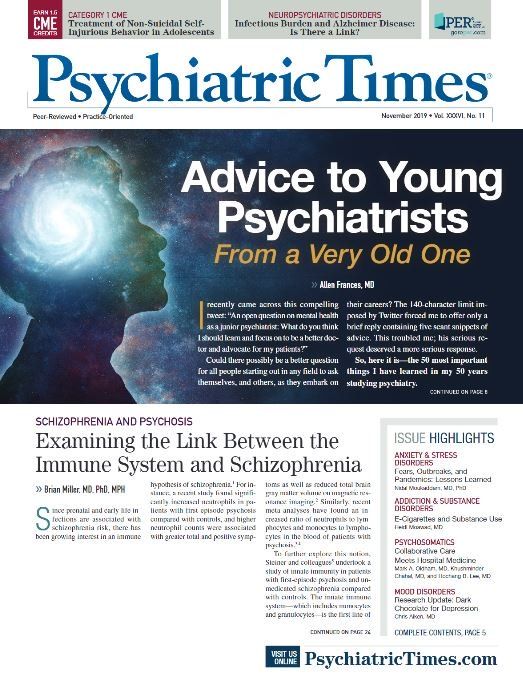Publication
Article
Psychiatric Times
OCD: A Common Psychiatric Disorder With a Constellation of Solutions
Author(s):
OCD is a serious psychiatric condition that can be effectively treated, with evidence-based approaches, in a majority of cases. There are, however, circumstances that complicate our treatment of OCD, and this article presents some of these issues.
©Sofio-Cracho/Shutterstock

Obsessive–compulsive disorder (OCD) is a common psychiatric disorder that affects approximately 2% of the world’s population. Without treatment, OCD often results in significant disability, increased rates of suicide, and the chance of remission is quite low. With appropriate treatment, however, patients report substantially higher rates of symptom response/remission.
Only approximately one-third of patients with OCD receive appropriate pharmacotherapy, and less than 10% receive evidence-based psychotherapy.1 First-line therapies include exposure and response prevention (ERP) (which uses repeated and prolonged exposures to fear-eliciting stimuli plus abstinence from compulsive behaviors), and serotonin reuptake inhibitors (ie, clomipramine or the selective serotonin reuptake inhibitors such as fluoxetine, sertraline).
When these medications are ineffective or only partially effective, a range of augmentation options (with varying degrees of supporting evidence) may be used (these include adding other serotonergic agents, antipsychotics, or glutamate modulators).
Beyond the above stated clinical approach, the actual treatment of OCD presents some unique issues clinicians should be aware of. This brief report highlights just a few of the clinical hurdles that OCD may present.
For example, 60% to 85% of patients report a considerable reduction in symptoms with ERP and improvement is often maintained for up to 5 years.2 The problem is that many people cannot find trained ERP therapists. Thus, the most effective treatment option for OCD is sometimes unavailable to them.
Another hurdle for many people with OCD is that the illness itself may prevent them from seeing their clinician or being compliant with treatment. Obsessions may make it impossible for the person to leave their home (eg, contamination obsessions make the person feel that leaving the home will result in bringing contaminants back into the home or being infected by something deadly).
In some cases, this may necessitate house calls on the part of the clinician. The obsessions may also include taking medication and therefore the very thing that could help them is avoided. In these instances, clinicians may need to be flexible and patient in their approach to the person.
Furthermore, the content of the obsessions in OCD may confuse clinicians and lead to incorrect diagnoses, such as when someone has sexual obsessions and they are misdiagnosed as having a paraphilia. The patients may not be forthcoming initially due to shame and embarrassment and so clinicians should take their time in eliciting all possible information concerning the sexual thoughts.
Because the SSRIs are often needed in higher doses than used for depression, clinicians may have concerns when treating OCD comorbid with other disorders such as bipolar disorder. The concern of switching someone into mania from the high doses of SSRIs may be counter-balanced by first starting an antiepileptic and then slowly titrating the SSRI to the needed dose.
Finally, in very rare cases of OCD that are refractory to all standard treatment approaches, a patient might consider neurosurgical interventions. Because these have been written about in the popular press, patients often inquire about them. It is important to first assess that the person has tried a true trial of quality ERP as well as multiple medication trials (ie, appropriate doses for the appropriate trial periods). In those instances where these have been tried, and an ethical board has reviewed the case independent of the clinician, then neurosurgery may be appropriate.
What these topics highlight is that OCD, like other psychiatric disorders, has evidence-based treatments but that there are often clinical aspects that complicate an easy implementation of those treatments. Clinicians treating OCD should be prepared for some of these potential hurdles and have ways of addressing them.
Further reading:
Cognitive-Behavioral Therapy for Refractory Cases: Turning Failure Into Success, by Dean McKay, PhD, ABPP; Jonathan S. Abramowitz, PhD, ABPP; and Steven Taylor, PhD, ABPP (Eds). Washington, DC: American Psychological Association; 2010.
Clinical Guide to Obsessive Compulsive and Related Disorders, by Jon E. Grant, JD, MD MPH; Samuel R. Chamberlain, MB/BChir, PhD, MRCPsych; and Brian L. Odlaug, MPH MPH. New York: Oxford University Press; 2014.
Dr Grant is Professor of Psychiatry and Behavioral Neuroscience at the University of Chicago. He spoke at the 2019 Psych Congress in San Diego, CA, in a presentation titled “Top 5 Complex Patients With OCD.”
Disclosures:
The author reports that he has received research grants from TLC Foundation and Promentis, Otsuka, and Biohaven Pharmaceuticals. Dr Grant receives yearly compensation from Springer Publishing for acting as Editor-in-Chief of the Journal of Gambling Studies and has received royalties from Oxford University Press, American Psychiatric Publishing, Inc., Norton Press, and McGraw Hill.
References:
1. Blanco C, Olfson M, Stein DJ, Simpson HB, et al. Treatment of obsessive-compulsive disorder by U.S. psychiatrists. J Clin Psychiatry. 2006;67:946-951.
2. Grant JE. Clinical practice: Obsessive-compulsive disorder. N Engl J Med. 2014;371:646-653.






